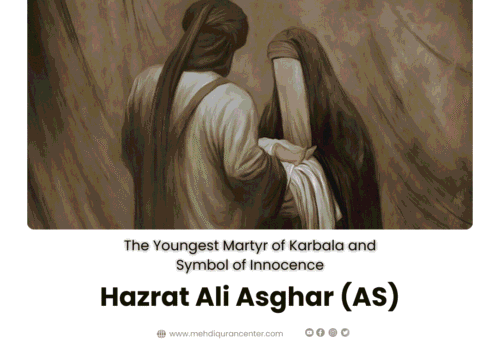1. Introduction
The story of Imam Ali ibn Hussain (A.S.), widely known as Imam Sajjad (A.S.) and Zain-ul-Abideen, is not just a chapter in Islamic history—it is a living legacy of spirituality, patience, and silent resistance. Born into the household of Imam Hussain (A.S.), he witnessed the horrors of Karbala and lived to uphold the message of Islam through worship and scholarship.
The Shahadat (martyrdom) of Imam Sajjad (A.S.) on the 25th of Muharram remains a mournful and reflective day for millions of Muslims around the world. But beyond mourning, his life provides spiritual tools and ethical guidance that remain deeply relevant even today.
2. The Lineage and Early Life of Imam Sajjad (A.S.)
Imam Sajjad (A.S.) was born in Medina in 38 AH (659 CE). His father was Imam Hussain ibn Ali (A.S.), the grandson of the Prophet Muhammad (PBUH), and his mother was Bibi Shahrbano, a noblewoman of Persian royal descent. This lineage gave him both spiritual and cultural richness.
Raised under the care of Imam Hussain (A.S.), he was deeply rooted in Quranic knowledge, prophetic traditions, and ethical conduct from an early age. He was just 22 years old when he accompanied his father to the plains of Karbala, where the course of history changed forever.
3. Imam Sajjad (A.S.) in Karbala
Though severely ill during the Battle of Karbala, Imam Sajjad (A.S.) was a witness to the unparalleled sacrifice of his family. He saw his father, brothers, uncles, and companions martyred one by one on 10th Muharram, 61 AH.
Unable to participate in the battle due to his illness, Imam Sajjad (A.S.) became the lone adult male survivor from the male descendants of Imam Ali (A.S.). His survival was not incidental—it was purposeful. Allah had chosen him to carry forward the message of Karbala to future generations.
4. Life in Captivity – Kufa and Damascus
After the massacre at Karbala, the Ahlul Bayt (family of the Prophet) were taken as prisoners. Imam Sajjad (A.S.), though weak, became the voice of truth in the palaces of tyrants. In the courts of Ibn Ziyad in Kufa and Yazid ibn Muawiya in Damascus, he boldly exposed the crimes committed against the Prophet’s family.
Despite his frail health, Imam Sajjad (A.S.) gave sermons that shook the audience, reminding them of their duty to Islam and the legacy of the Prophet Muhammad (PBUH). These speeches ignited guilt and outrage among the people and sowed the seeds of future resistance against the Umayyads.
5. The Return to Medina – Building a Silent Revolution
Upon returning to Medina, Imam Sajjad (A.S.) began a different kind of revolution—one of education, prayer, and spiritual healing. His mission was not political in the traditional sense. Rather, it was a restoration of moral consciousness in a time of widespread corruption.
The Imam avoided overt political rebellion, knowing that the oppressive Umayyad regime would crush any direct confrontation. Instead, he trained students, composed supplications, and preserved Islamic values through hidden but powerful methods.
6. The Teachings of Imam Sajjad (A.S.)
Imam Sajjad (A.S.) laid great emphasis on:
- Human dignity and rights
- Social justice
- Charity and community service
- The importance of du’a (supplication) and tawakkul (reliance on Allah)
- Opposing tyranny through moral strength and knowledge
His behavior with slaves, orphans, widows, and even enemies was filled with compassion. He revived the Prophetic character in a time when the Muslim community had strayed from its ethical foundations.
7. Sahifa Sajjadiya – The Psalms of Islam
One of Imam Sajjad’s most lasting contributions to Islamic spirituality is the Sahifa Sajjadiya, a collection of 54 deeply moving and theologically profound du’as (supplications). This work is a spiritual guide for Muslims, similar in scope to the Psalms of David in Judeo-Christian tradition.
The topics covered include:
- Du’as for parents, children, neighbors, and the oppressed
- Pleas for forgiveness, mercy, and divine justice
- Expressions of gratitude, grief, and hope
Through these supplications, Imam Sajjad (A.S.) educated hearts, not just minds. He transformed du’a into a tool of resistance, spiritual purification, and education.
8. The Political Climate of the Umayyads
The Umayyad dynasty, particularly under Yazid and later rulers like Walid ibn Abdul Malik, sought to distort Islamic principles and suppress the influence of the Ahlul Bayt.
Imam Sajjad (A.S.), by virtue of his lineage and popularity, was viewed as a threat. His silent revolution gained a large following—especially among the oppressed, scholars, and pious communities. The regime feared that his spiritual authority could eventually lead to a political uprising.
9. The Shahadat of Imam Sajjad (A.S.)
Imam Sajjad (A.S.) was poisoned on 25th Muharram, 95 AH (713 CE) on the orders of Caliph Walid ibn Abdul Malik. He was around 57 years old at the time of his martyrdom.
This act of treachery was a continuation of the Umayyad policy of eliminating the voices of truth. Despite living a life of worship, peace, and humility, Imam Sajjad’s influence was so significant that the tyrants could not tolerate his presence.
He was buried in Jannat al-Baqi cemetery in Medina, next to his uncle Imam Hasan (A.S.) and other members of the Ahlul Bayt.
10. The Significance of 25th Muharram
Every year, the 25th of Muharram is commemorated by Shia Muslims and lovers of the Ahlul Bayt as the day of Shahadat of Imam Sajjad (A.S.). The day is marked by:
- Mourning processions
- Du’as and Ziyarat of the Imam
- Recitation from Sahifa Sajjadiya
- Educational sessions on his life and teachings
The 25th Muharram serves as a reminder that the struggle for truth does not end on the battlefield. It continues through education, worship, and resilience.
11. Global Commemorations
Imam Sajjad (A.S.) is remembered and mourned globally, especially in:
🇮🇶 Iraq (Najaf & Karbala)
Thousands gather in processions to honor his Shahadat, with recitations and Majalis in his name.
🇮🇷 Iran (Qom, Mashhad, Tehran)
Large congregations participate in night-long vigils and scholarly discussions.
🇵🇰 Pakistan (Lahore, Karachi, Rawalpindi)
Majalis and Alam processions are organized, with Sahifa Sajjadiya distributed widely.
🇮🇳 India (Lucknow, Hyderabad, Kashmir)
Traditional Azadari includes Nauhas, Ziyarat-e-Ashura, and reflections on his life.
🇬🇧 🇺🇸 🇨🇦 UK, USA, and Canada
Shia Islamic centers host live events, lectures, and community outreach programs themed on his teachings.
12. Reflections on His Legacy
Imam Sajjad (A.S.) is a symbol of post-tragedy resilience. Where most would have crumbled under emotional trauma and grief, he stood as a pillar of strength. His life teaches:
- That spiritual reform is more powerful than political power
- That words and prayers can change hearts
- That truth lives on, even when bodies perish
He single-handedly preserved the ethical soul of Islam after the bloodshed of Karbala.
13. Lessons from His Life for Today
📌 Spirituality Over Politics
In today’s world filled with conflict and misinformation, Imam Sajjad’s life reminds us to return to prayer, character, and humility.
📌 The Power of Words
His sermons and duas continue to shape Islamic thought 1,400 years later. Our words, too, carry weight—use them to uplift and awaken, not divide.
📌 Standing for Justice Quietly
You don’t always need a podium or power to resist injustice. Even a sick, silent Imam in chains changed history.
📌 Parenting and Moral Education
He raised Imam Muhammad al-Baqir (A.S.), who carried forward the next stage of Islamic scholarship. Teach your children the power of truth, even in adversity.
14. Conclusion
The Shahadat of Imam Sajjad (A.S.) is not just a death—it’s the celebration of a lifelong mission of spiritual leadership. Through patience, prayer, and inner strength, he carried the torch of Islam from the ashes of Karbala to the hearts of generations.
In our fast-paced and unjust world, his legacy offers the perfect balance of devotion and resistance, compassion and courage, grief and growth.
Let us remember him not just in mourning, but in action—by reciting Sahifa Sajjadiya, promoting justice, supporting the oppressed, and living with integrity.








